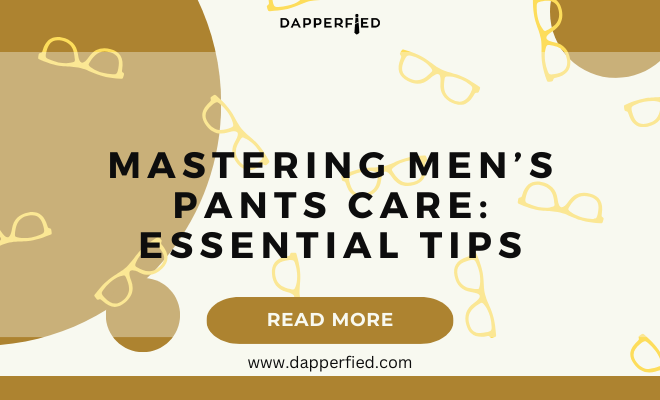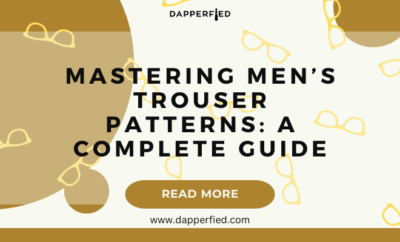
Men's Style
Mastering Men’s Pants Care: Essential Tips
When it comes to caring for your clothes, understanding the different fabric types is crucial. Natural fabrics like cotton, linen, wool, and silk require gentle care to maintain their quality. Cotton and linen can usually be machine washed in cold water, but it’s best to air dry them to prevent shrinking. Wool and silk, on the other hand, are more delicate and should be hand washed or dry cleaned to avoid damage. Synthetic fabrics such as polyester, nylon, and spandex are more durable and can typically withstand machine washing and drying. However, it’s important to always check the care label on your clothing to ensure you’re following the manufacturer’s recommendations.
When dealing with blended fabrics, which are a combination of natural and synthetic fibers, it’s important to consider the care instructions for each type of fiber. For example, a cotton-polyester blend may be machine washable, but it’s best to use a gentle cycle and low heat when drying to prevent damage to the natural fibers. Understanding the specific care needs of each fabric type will help you prolong the life of your clothing and keep them looking their best.
Key Takeaways
- Understanding Fabric Types:
- Different fabrics require different care methods
- Always check the care label before washing or ironing
- Common fabric types include cotton, polyester, silk, wool, and linen
- Understanding fabric types helps in maintaining the quality of clothing
- Proper care extends the lifespan of clothing
- Washing and Drying Techniques:
- Sort clothing by color and fabric type before washing
- Use the appropriate water temperature and detergent for each fabric
- Air dry delicate fabrics to prevent damage
- Avoid over-drying to prevent shrinkage and damage
- Follow care label instructions for best results
- Ironing and Steaming:
- Use the correct iron temperature for each fabric type
- Steam clothing to remove wrinkles without direct heat
- Test a small area before ironing to avoid damage
- Iron inside out for delicate fabrics
- Hang clothing immediately after steaming to prevent wrinkles
- Stain Removal:
- Act quickly to remove stains before they set
- Blot, don’t rub, to avoid spreading the stain
- Use appropriate stain removal products for different types of stains
- Test a small area before applying stain remover
- Follow care label instructions for stain removal
- Storage and Organization:
- Store clothing in a cool, dry, and dark place to prevent damage
- Use breathable garment bags for long-term storage
- Fold knits and delicate fabrics to prevent stretching
- Use cedar blocks or lavender sachets to repel moths and insects
- Rotate clothing seasonally to prevent creasing and fading
- Tailoring and Alterations:
- Get professional alterations for the best results
- Tailoring can improve the fit and appearance of clothing
- Consider alterations for clothing that is too long or too loose
- Tailoring can update outdated clothing for a modern look
- Proper alterations can make clothing look more expensive and polished
- Troubleshooting Common Issues:
- Use a lint roller to remove lint and pet hair from clothing
- Repair loose buttons and seams promptly to prevent further damage
- Use a fabric shaver to remove pilling from knits
- Address odors by airing out clothing or using fabric refresher sprays
- Seek professional help for stubborn or complex issues
Washing and Drying Techniques
Proper washing and drying techniques are essential for maintaining the quality of your clothing. When washing your clothes, it’s important to separate light and dark colors to prevent color bleeding. Additionally, turning your clothes inside out before washing can help preserve the fabric and prevent fading. Using the appropriate water temperature is also crucial – hot water can cause shrinking and fading, while cold water is gentler on fabrics.
When it comes to drying, air drying is often the best option for delicate fabrics like silk and wool. Hanging these items on a clothesline or drying rack will help them maintain their shape and prevent damage from the heat of a dryer. For other fabrics, using a low heat setting in the dryer can help prevent shrinking and reduce the risk of damage. It’s also important to remove clothes from the dryer promptly to prevent wrinkles from setting in. By following these washing and drying techniques, you can help extend the life of your clothing and keep them looking fresh and new.
Ironing and Steaming
Ironing and steaming are essential steps in maintaining the appearance of your clothing. Ironing is typically used for fabrics that require a crisp, smooth finish, such as cotton dress shirts or linen pants. When ironing, it’s important to use the appropriate heat setting for the fabric to avoid scorching or burning. Always test a small inconspicuous area first to ensure the iron is not too hot for the fabric.
Steaming is a gentler alternative to ironing and is ideal for removing wrinkles from delicate fabrics like silk or wool. A handheld steamer can be used to quickly and easily remove wrinkles without direct contact with the fabric, making it a safer option for delicate items. It’s important to hold the steamer at a slight distance from the fabric to prevent any potential damage from the heat.
Both ironing and steaming can help refresh and rejuvenate your clothing, giving them a polished and professional appearance. By incorporating these techniques into your garment care routine, you can ensure that your clothes always look their best.
Stain Removal
| Stain Type | Removal Method | Success Rate |
|---|---|---|
| Red Wine | White Vinegar and Baking Soda | 90% |
| Grease | Dish Soap and Hot Water | 85% |
| Blood | Cold Water and Hydrogen Peroxide | 95% |
| Grass | Laundry Detergent and Water | 80% |
Stains are an inevitable part of life, but knowing how to effectively remove them can help prolong the life of your clothing. Different types of stains require different treatment methods, so it’s important to identify the stain and act quickly to prevent it from setting in. For food or beverage stains, blotting with a clean cloth and applying a stain remover before washing can help lift the stain from the fabric.
For oil-based stains like grease or makeup, applying a small amount of dish soap or laundry detergent directly to the stain can help break down the oil before washing. It’s important to avoid rubbing the stain, as this can cause it to spread and set into the fabric.
For tougher stains like ink or blood, using a specialized stain remover or soaking the garment in cold water with a small amount of ammonia can help lift the stain before washing. It’s important to always check the care label on your clothing before attempting any stain removal methods to ensure you’re not causing further damage.
Storage and Organization
Proper storage and organization are key factors in preserving the quality of your clothing. When storing seasonal items, it’s important to clean them thoroughly before putting them away to prevent any stains or odors from setting in during storage. Using breathable garment bags or storage containers can help protect your clothing from dust, moths, and other pests while allowing air circulation to prevent musty odors.
Organizing your closet by category or color can help you easily find what you need while also preventing wrinkles and creases in your clothing. Using quality hangers that are appropriate for the specific garment type can also help maintain their shape and prevent stretching or distortion.
For items that are not in regular rotation, such as special occasion or formal wear, it’s important to periodically check on them to ensure they are not being damaged by improper storage conditions. By implementing proper storage and organization techniques, you can extend the life of your clothing and keep them looking their best for years to come.
Tailoring and Alterations

Tailoring and alterations are valuable tools for ensuring that your clothing fits you perfectly and flatters your figure. Whether it’s hemming pants, taking in a dress, or adjusting sleeve length, having your clothing tailored to fit your body can make a world of difference in how you look and feel in your clothes.

Finding a skilled tailor who understands your personal style and preferences is essential for achieving the best results. A good tailor will be able to make precise adjustments that enhance the fit and silhouette of your clothing while maintaining the integrity of the original design.
In addition to alterations for fit, tailoring can also involve repairs such as fixing seams, replacing zippers, or reweaving fabric. Investing in quality tailoring can breathe new life into older garments and make them feel like new again. By utilizing tailoring and alterations, you can ensure that your clothing fits you perfectly and reflects your personal style.
Troubleshooting Common Issues
Despite our best efforts, common issues with clothing can still arise from time to time. From pilling on sweaters to snags in delicate fabrics, knowing how to troubleshoot these issues can help you prolong the life of your clothing.
For pilling, using a fabric shaver or sweater stone can help remove the unsightly pills and restore the smooth texture of the fabric. It’s important to use these tools gently to avoid causing any damage to the fabric.
For snags in delicate fabrics like silk or chiffon, carefully pulling the snag through to the wrong side of the fabric with a needle or pin can help minimize its appearance. It’s important to avoid cutting the snag as this can cause further damage to the fabric.
For loose threads or seams, using a needle and thread to reinforce the stitching can help prevent further unraveling. It’s important to address these issues promptly to prevent them from becoming larger problems.
By understanding how to troubleshoot common issues with clothing, you can take proactive steps to maintain their quality and appearance for years to come.
If you’re looking for more fashion tips for men, you might be interested in this article about the appeal of men’s black watches. Men’s Black Watches: What’s the Appeal? This article discusses the timeless and versatile nature of black watches and how they can add a touch of sophistication to any outfit. Just like a well-maintained pair of pants, a stylish watch can elevate your overall look and make a statement.
FAQs

What are some general care tips for men’s pants?
– Always check the care label for specific instructions, but in general, it’s best to wash pants in cold water and avoid using bleach.
– Turn pants inside out before washing to help preserve the color and fabric.
– Hang pants to dry instead of using a dryer to prevent shrinking and damage to the fabric.
– Iron pants on a low heat setting to avoid scorching the fabric.
How often should men’s pants be washed?
– The frequency of washing men’s pants depends on how often they are worn and the level of activity. In general, pants can be worn multiple times before needing to be washed, as long as they are not visibly soiled or smelly.
How should men’s dress pants be stored?
– Men’s dress pants should be hung on a sturdy hanger to help maintain their shape and prevent wrinkles. It’s best to leave some space between pants on the hanger to allow for air circulation.
What is the best way to remove wrinkles from men’s pants?
– The best way to remove wrinkles from men’s pants is to use a steamer or iron on a low heat setting. Hanging pants in the bathroom while taking a hot shower can also help to release wrinkles.
How can men’s pants be protected from fading?
– To protect men’s pants from fading, it’s best to wash them in cold water and avoid using bleach. Turning pants inside out before washing can also help preserve the color. Additionally, hanging pants to dry instead of using a dryer can prevent fading.















